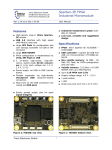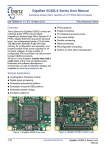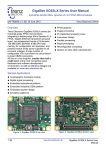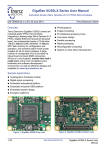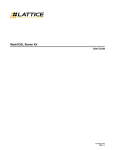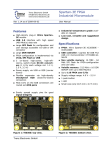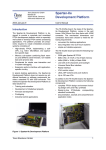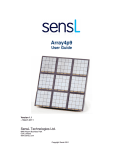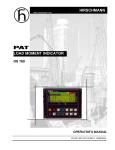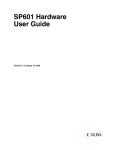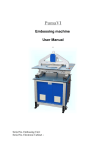Download TE0630 Spartan-6 FPGA Industrial Micromodule
Transcript
TE0630 Spartan-6 FPGA Industrial Micromodule User Manual UM-TE0630 (v 0.21) 3 July 2013 Trenz Electronic GmbH Features Specifications ● High-density plug-in Xilinx Spartan-6 module ● USB 2.0 interface with high-speed (480 Mbit/s) data rate ● Large SPI Flash for configuration and user data, accessible via FPGA, JTAG and USB interfaces ● Large DDR3 SDRAM ● FPGA configuration via SPI, JTAG or USB ● 3 high-efficiency on-board switch-mode DC-DC converters ● Power supply from B2B connector (carrier board) or USB connector ● Flexible expansion via high-density shockproof B2B connectors ● Most user I/Os on B2B connectors routed as LVDS pairs ● Evenly spread supply pins for good signal integrity ● Industrial temperature grade available upon request ● Low-cost, versatile and ruggedized design ● Small size ● FPGA - XC6SLX45/75/100/1502CSG484C(I) ● USB-controller: CY7C68013A-56LTXC(I) ● Non-volatile memory: 64 Mbit SPI Flash for configuration and user data ● Volatile memory: 1 Gb x 16 DDR3 SDRAM ● Up to 110 FPGA user I/O ● Supply voltage range: 4.0 V - 5.5 V ● 1 user push-button ● 4 user LEDs ● 2 user DIP switches ● Dimensions: 40.5 mm x 47.5 mm 1/39 www.trenz-electronic.de TE0630 Spartan-6 FPGA Industrial Micromodule UM-TE0630 (v 0.21) 3 July 2013 Table of Contents 1 Technical Specifications...............................................................................................................4 1.1 Module options.....................................................................................................................4 1.2 Dimensions...........................................................................................................................4 2 Detailed Description.....................................................................................................................5 2.1 Block Diagram......................................................................................................................5 2.2 Power Supply.......................................................................................................................5 2.2.1 Supply from B2B Connector.........................................................................................5 2.2.2 Supply from USB Connector.........................................................................................5 2.2.3 On-board Power Rails...................................................................................................6 2.2.4 Power-on Reset............................................................................................................7 2.3 FPGA User I/Os....................................................................................................................8 2.4 Board-to-board Connectors..................................................................................................9 2.5 USB Connector..................................................................................................................10 2.6 JTAG connector..................................................................................................................11 2.7 Serial EEPROM..................................................................................................................11 2.8 SPI Flash............................................................................................................................11 2.9 DDR3 SDRAM....................................................................................................................12 2.10 USB Controller.................................................................................................................12 2.11 Clock Oscillators...............................................................................................................13 2.12 LEDs.................................................................................................................................13 2.13 Push-Button......................................................................................................................14 2.14 DIP Switch........................................................................................................................14 2.15 Board revisions and assembly variants...........................................................................14 3 TE0300 compatibility.................................................................................................................15 3.1 Mechanical compatibility....................................................................................................15 3.2 Electrical compatibility........................................................................................................15 4 Module Configuration................................................................................................................17 4.1 JTAG FPGA Configuration.................................................................................................17 4.2 SPI FPGA Configuration.....................................................................................................18 4.3 eFUSE programming..........................................................................................................18 4.4 EZ-USB FX2 Firmware Programming................................................................................18 4.5 EZ-USB FX2 EEPROM Programming...............................................................................19 5 USB Drivers Installation.............................................................................................................21 5.1 Generic Driver....................................................................................................................21 5.2 Dedicated Driver.................................................................................................................24 6 B2B Connectors Pin Descriptions.............................................................................................26 6.1 Pin Labelling.......................................................................................................................27 6.2 Pin Types............................................................................................................................27 6.3 J4 Pin-out...........................................................................................................................28 6.4 J5 Pin-out...........................................................................................................................29 6.5 Signal Integrity Considerations..........................................................................................30 7 Related Materials and References............................................................................................30 7.1 Data Sheets........................................................................................................................30 7.2 User Guides........................................................................................................................30 8 Glossary of Abbreviations and Acronyms..................................................................................30 9 Legal Notices.............................................................................................................................31 9.1 Document Warranty............................................................................................................31 9.2 Limitation of Liability...........................................................................................................31 9.3 Copyright Notice.................................................................................................................31 2/39 www.trenz-electronic.de TE0630 Spartan-6 FPGA Industrial Micromodule UM-TE0630 (v 0.21) 3 July 2013 9.4 Technology Licenses..........................................................................................................32 10 Environmental Protection........................................................................................................33 10.1 REACH (Registration, Evaluation, Authorisation and Restriction of Chemicals) Compliance Statement.............................................................................................................33 10.2 RoHS (Restriction of Hazardous Substances) compliance statement............................33 10.3 WEEE (Waste Electrical and Electronic Equipment).......................................................33 Appendix A. Indirect SPI Programming using iMPACT...............................................................35 Document Change History..........................................................................................................39 3/39 www.trenz-electronic.de TE0630 Spartan-6 FPGA Industrial Micromodule 1 Technical Specifications UM-TE0630 (v 0.21) 3 July 2013 1 Technical Specifications 1.1 Module options FPGA options Module can be ordered with Spartan-6 XC6SLX45, XC6SLX75, XC6SLX100, XC6SLX150 chip1. Temperature grade options Module can be ordered in commercial or in extended (from -25 C° to +85 C°) temperature grade. 1.2 Dimensions Figure 1 shows main module dimensions from top view. Figure 1: Module dimensions in mm Mounting hole diameter is 3.2 mm. 1 Contact Trenz Electronic support for availability 4/39 www.trenz-electronic.de TE0630 Spartan-6 FPGA Industrial Micromodule 2 Detailed Description UM-TE0630 (v 0.21) 3 July 2013 2 Detailed Description 2.1 Block Diagram Figure 2: TE0630 block diagram 2.2 Power Supply The module can be powered by B2B connector J5 or the USB connector. If both power supplies are available, the B2B connector power supply takes precedence, disabling the USB power supply automatically. 2.2.1 Supply from B2B Connector The B2B connector power supply requires a single nominal 5 V DC power supply. The power is usually supplied to the module through the 5 V contacts (5Vb2b) of B2B connector J5 (see chapter 6.4 J5 Pin-out). The recommended minimum supply voltage is 4 V. The maximum supply voltage is 5.5 V. The recommended maximum continuous supply current is 1.5 A. 2.2.2 Supply from USB Connector The module is powered by the USB connector if the following conditions are met: ● the module is equipped with an USB connector, ● the module is connected to a USB bus, 5/39 www.trenz-electronic.de TE0630 Spartan-6 FPGA Industrial Micromodule 2 Detailed Description UM-TE0630 (v 0.21) 3 July 2013 ● no power supply is provided by B2B connectors. In this case, other components (e.g. extension or carrier boards) may also be powered by the corresponding 5 volt line (5V) of B2B connector J5. 2.2.3 On-board Power Rails Three on-board voltage regulators provide the following power supply rails needed by the components on the module: ● 1.2V, 3.0 A max ● 2.5V, 0.8 A max ● 3.3V, 3.0 A max ● 1.5V, 1.0 A max Figure 3 show power supply diagram. Figure 3: TE0630 Power diagram The power rails are available for the FPGA and can be shared with a carrier board by the corresponding lines of the B2B connectors J4 and J5. Please note that the power consumption of the FPGA is highly dependent on the design actually loaded. So please use a tool like Xilinx Xpower to estimate the expected power consumption of your design. Even if the provided voltages of the module are not used on the carrier board, it is recommended to bypass them to ground with 10 nF - 100 nF capacitors. FPGA I/O banks power supply Spartan-6 architecture organizes I/Os into four I/O banks, see Table 1 for supply voltage used for each bank. VCCIO0 voltage can be configured in 3 ways: ● 2.5V - When resistor R103 is populated and resistor R102 is not populated. ● 3.3V - When R103 is not populated and resistor R102 is populated. 6/39 www.trenz-electronic.de TE0630 Spartan-6 FPGA Industrial Micromodule 2 Detailed Description UM-TE0630 (v 0.21) 3 July 2013 ● External supply - When R103 is not populated and R102 is not populated. In this case external supply source have to be connected to pins 1, 2, 3, 4 of J4 B2B connector2. Others options of VCCIO0 power supply are not supported and can damage the FPGA! See Figure 4 to locate R102 and R103 on PCB. Figure 4: R102 and R103 location Bank Supply Voltage B0 VCCIO0 B1 1.5V B2 3.3V B3 3.3V Table 1: FPGA banks VCCIO power supply Note that some of Spartan-6 I/O types are partially compatible, so pins of compatible types can be used as inputs for signal of other type. See “Spartan-6 FPGA SelectIO Resources” page 38 for detailed information. 2.2.4 Power-on Reset During power-on, the /RESET line is first asserted. Thereafter, the supply voltage supervisor monitors the power supply rail 3.3V and keeps the /RESET line active (low) as long as the supply rail remains below the threshold voltage(2.93 volt). An internal timer delays the return of the /RESET line to the inactive state (high) to ensure proper system reset prior to a regular system start-up. The typical delay time td of 200 ms starts after the supply rail has risen 2 See Spartan-6 documentation fo VCCIO power range. 7/39 www.trenz-electronic.de TE0630 Spartan-6 FPGA Industrial Micromodule 2 Detailed Description UM-TE0630 (v 0.21) 3 July 2013 above the threshold voltage. Figure 5: Reset on power-on After this delay, the /RESET line is reset (high) and the FPGA configuration can start. When the supply rail voltage drops below the threshold voltage, the /RESET line becomes active (low) again and stays active (low) as long as the rail voltage remains below the threshold voltage (2.93 volt). Once the rail voltage raises again and remains over the threshold voltage for more than the typical delay time td of 200 ms, the /RESET line returns to the inactive state (high) to allow a new system start-up. 2.3 FPGA User I/Os TE0630 provides user I/O signals connected to B2B connectors J4 and J5. There are 3 types of user I/O signals: ● Single ended; ● Differential pairs (each pair is configurable as 2 single-ended digital I/Os); ● Differential pairs, which can be used as clock inputs (each pair can be used as usual differential pair or 2 single-ended digital I/Os). Table 2 show user I/O count for J4 and J5. J4 J5 Total Single ended 12 18 30 Differential 18 16 34 Differential (clock) 4 2 6 Total 56 54 110 Table 2: User I/O count by connector Table 3 show user I/O divided by VCCIO supply voltage. VCCIO0 3.3V Total Single ended 1 29 30 Differential 18 16 34 Differential (clock) 4 2 6 Total 45 65 110 Table 3: User I/O count by VCCIO 8/39 www.trenz-electronic.de TE0630 Spartan-6 FPGA Industrial Micromodule 2 Detailed Description UM-TE0630 (v 0.21) 3 July 2013 2.4 Board-to-board Connectors The module has two B2B (board-to-board) receptacle connectors (J4 and J5) for a total of 160 contacts. Figure 6 shows B2B connectors location on board; USB connector is located on the top side and is shown to define module position. Figure 6: B2B connectors location TE0630 uses high-density shockproof connectors shown in Figure 7. Connector part numbers are listed in Table 4. Figure 7: Module connector Supplier Header Digikey H11113CT-ND H11113TR-ND H11113DKR-ND Hirose DF17(3.0)-80DS-0.5V(57) Trenz Electronic 22684 Table 4: Module connectors part numbers The on-board receptacles mate with their corresponding headers on the carrier board shown in Figure 8. Ordering numbers of mating connectors are listed in Table 5. 9/39 www.trenz-electronic.de TE0630 Spartan-6 FPGA Industrial Micromodule 2 Detailed Description UM-TE0630 (v 0.21) 3 July 2013 Figure 8: Mating (carrier board) connector Supplier Header Digikey H11148DKR-ND H11148TR-ND H11148CT-ND Hirose DF17(4.0)-80DP-0.5V(57) Trenz Electronic 22938 Table 5: Carrier board headers part numbers. Figure 9 shows the definition of stacking height featured by the combination of the TE0630 receptacle with its corresponding header. Figure 9: B2B stacking The stacking height of the TE0630 B2B connectors is 7 (seven) mm. The stacking height does not include the solder paste thickness. 2.5 USB Connector The module uses a mini-USB (B type) receptacle connector. 10/39 www.trenz-electronic.de TE0630 Spartan-6 FPGA Industrial Micromodule 2 Detailed Description UM-TE0630 (v 0.21) 3 July 2013 Figure 10: Mini-USB connector 2.6 JTAG connector The offset holes of header J2 allow a removable press fit of standard 0.100 inch header pins to connect flying leads without any soldering necessary. JTAG signals are available on the dedicated header J2 through a JTAG programmer with flying leads as described in Table 6. TMS TDI TDO TCK GND Vref (2.5 V) Table 6: JTAG header J2 pin-out 2.7 Serial EEPROM TE0630 is equipped with a Micron Technology 24LC128 128 K I2C CMOS Serial EEPROM (U1). It is used for EZ-USB FX2 firmware, vendor ID and device ID storage. EEPROM is accessible through the EZ-USB FX2 microcontroller. 2.8 SPI Flash TE0630 is equipped with a Winbond W25Q64BV 64 Mb (8 MB) serial flash memory chip (U14). This serial flash chip can operate as general SPI memory mode and in double or quad modes. Usage of dual and quad modes increase bandwidth up to 40 MB/s. For more information see Winbond W25Q64BV product owerview. 11/39 www.trenz-electronic.de TE0630 Spartan-6 FPGA Industrial Micromodule 2 Detailed Description UM-TE0630 (v 0.21) 3 July 2013 2.9 DDR3 SDRAM TE0630 is equipped with a 1 Gb (128 MB) DDR3 SDRAM chip. DDR3 memory is connected to FPGA bank 1. 2.10 USB Controller TE0630 is equipped with a Cypress EZ-USB FX2 controller to provide a highspeed USB 2.0 interface. The controller uses 4 interfaces (See chapter 2.1 Block Diagram): ● USB interface (to USB connector); ● I2C interface (to EEPROM); ● SPI interface (to FPGA and Flash); ● FIFO interface (to FPGA). The I2C interface connects the USB controller to the EEPROM chip, which stores vendor ID and device ID. See chapter 2.14 DIP Switch for available options. The SPI interface id used to communicate with the FPGA and to access the SPI serial Flash chip. The FIFO interface provides a high-speed communication channel with the FPGA. The interface can transfer up to 48 MB/s burst rate. FPGA pin-out information can be found in Table 7. 12/39 www.trenz-electronic.de TE0630 Spartan-6 FPGA Industrial Micromodule 2 Detailed Description UM-TE0630 (v 0.21) 3 July 2013 Signal name FPGA pin FD0 J6 FD1 H8 FD2 H5 FD3 H6 FD4 G7 FD5 G8 FD6 F8 FD7 A3 24MHZ1 G3 PA0/INT0 D1 PA1/INT1 D2 PA2/SLOE C1 PA3/WU E4 PA4/FIFOADDR0 B1 PA5/FIFOADDR1 C3 PA6/PKTEND B2 PA7/FLAGD/SLCS A2 RDY1/SLWR M3 RDY0/SLRD M4 CTL2/FLAGC E3 CTL1/FLAGB E1 CTL0/FLAGA F3 IFCLK N4 Table 7: USB controller interface: FPGA pin-out 2.11 Clock Oscillators Two clock oscillators are installed on the TE0630. Clock oscillator U10 generates a 24 MHz clock signal for the FPGA and the USB controller. This clock signal is used for synchronous communication between FPGA and USB controller. Clock oscillator U11 generates a 100 MHz3 clock signal used as a main system clock in FPGA designs. See Table 8 for pin-out information. Signal Frequency FPGA pin 24MHZ1 24 MHz G3 SYSCLK 100 MHz AA12 Table 8: Clock signals pin-out 2.12 LEDs TE0630 is equipped with four active-high LEDs. See Table 9 for details. 3 Oscillator frequency can be changed by user request. Contact Trenz Electronic for details. 13/39 www.trenz-electronic.de TE0630 Spartan-6 FPGA Industrial Micromodule 2 Detailed Description UM-TE0630 (v 0.21) 3 July 2013 Signal name FPGA pin LED U_LED1 F1 D3 U_LED2 F2 D5 U_LED3 J4 D6 U_LED4 K8 D7 Table 9: LEDs pin-out 2.13 Push-Button TE0630 module is equipped with one active-high push-button (signal is set to logical "1" when button is pressed). Table 10 show push-button connection details. Signal name FPGA pin PB PB R7 S5 Table 10: Push button pin-out 2.14 DIP Switch On-board 4xDIP switch S1 used for system and user settings. Switch 1 (S1A) is used to connect the USB controller to the I 2C serial EEPROM. When S1A is "ON", serial I2C EEPROM is connected to the USB controller, when switch is "OFF", the USB controller is disconnected from the EEPROM 4. Turn S1A off when programming the USB EEPROM (storing the USB vendor ID and device ID). This will force the USB controller to provide its default vendor ID and device ID. Switch 2 (S1B) is used to control DC-DC converters. When switch is "OFF", converters are controlled by the USB controller. When switch is "ON", converters are enabled regardless of USB controller actions. At start-up, the USB controller switches off 1.2V, 1.5V and 2.5V power rails and starts up the module in low-power mode. After enumeration, the USB controller firmware switches the 1.2V, 1.5V and 2.5V power rails on, if enough current is available from the USB bus. Switches 3 (S1C) and 4 (S1D) can be used as user switches. Switches are active-low. Pull-up resistors should be defined in user constrains file (UCF) to use this switches in FPGA design. See Table 11 for details. Signal name FPGA pin Switch IO_L61_N_1 AB21 S1C IO_L63_N_1 AA22 S1D Table 11: DIP switch pin-out 2.15 Board revisions and assembly variants To determine PCB revision and assembly variant from FPGA, TE0630 have dedicated user signals, which can be read by user core. Board revision coded in 4 bits BR[3:0] 4 Zero-resistor R90 (not populated by default) short this switch and connect EEPROM regardless of S1A position. 14/39 www.trenz-electronic.de TE0630 Spartan-6 FPGA Industrial Micromodule 2 Detailed Description UM-TE0630 (v 0.21) 3 July 2013 Signal name FPGA pin BR0 R19 BR1 V19 BR2 V20 BR3 T17 Table 12: Board revision pins To define low (zero) level BR pin connected to ground rail, to define high (one) level BR pin left float (open). These pins should be configured with "pullup" option in user design. See Table 12 for current list of board revisions. BR3 BR2 BR1 BR0 0 0 0 0 00 Initial revision Table 13: Board revisions Module assembly variant encoded using AV[3:0] pins. Signal name FPGA pin AV0 Y20 AV1 R15 AV2 R16 AV3 R17 Table 14: Assembly variants pins To define low (zero) level AV pin connected to ground rail through zero resistor, to define high (one) level AV pin left float (open). These pins should be configured with "pullup" option in user design. Available module assembly variants listed in Table 15. AV3 AV2 AV1 AV0 0 0 0 0 Base assembly variant Table 15: Module assembly variants 3 TE0300 compatibility TE0630 module designed to be compatible with TE0300 board by main mechanical and electrical characteristics. 3.1 Mechanical compatibility Both modules have the same board dimensions. TE0630 mount holes and B2B connectors locations are match with TE0300. See chapter 1.2 Dimensions for detailed information. TE0300 and TE0630 uses same B2B connectors types. In chapter 2.4 Boardto-board Connectors you can find B2B connectors part numbers and main characteristics. 3.2 Electrical compatibility TE0300 and TE0630 have similar power requirements and matched power input pins. User signals to B2B connectors routed as differential pairs and single 15/39 www.trenz-electronic.de TE0630 Spartan-6 FPGA Industrial Micromodule 3 TE0300 compatibility UM-TE0630 (v 0.21) 3 July 2013 ended lines. Differences in pin types shown in Table 16, not listed signals have same or compatible5 type. Connector:Pin TE0300 pin name TE0300 Type TE0630 pin name TE0630 Type J4:5 B3_L01_P DIO V3_IO_01 SIO J4:7 B3_L01_N DIO V3_IO_02 SIO J4:9 B3_L02_P DIO V3_IO_03 SIO J4:11 B3_L02_N DIO V3_IO_04 SIO J4:17 B0_L24_N DIO V0_IO_01 SIO J4:19 B0_L24_P DIO V0_IO_01_N DIO J4:6 B3_L07_P DIO V3_IO_06 SIO J4:8 B3_L07_N DIO V3_IO_07 SIO J4:10 B3_L03_N DIO V3_IO_08 SIO J4:12 B3_L03_P DIO V3_IO_09 SIO J5:13 B3_L22_P DIO V3_IO_12 SIO J5:15 B3_L22_N DIO V3_IO_13 SIO J5:19 B3_L20_P DIO V3_IO_14 SIO J5:21 B3_L20_N DIO V3_IO_15 SIO J5:16 B3_L21_N DIO V3_IO_17 SIO J5:18 B3_L21_P DIO V3_IO_18 SIO J5:20 B3_L23_N DIO V3_IO_19 SIO J5:22 B3_L23_P DIO V3_IO_20 SIO J5:32 B2_L06_P DIO V3_IO_24 SIO J5:34 B2_L06_N DIO V3_IO_25 SIO J5:41 B2_GCLK13 CIO V2_IO_02 SIO J5:49 B2_GCLK_L13_N CIO V2_IO_24_P DIO J5:51 B2_GCLK_L13_P CIO V2_IO_24_N DIO Table 16: TE0300 and TE0630 pin types differences. See Table 17 for pin types definitions. Type colour code Description DIO Unrestricted, general-purpose differential user-I/O pin. SIO Unrestricted, general-purpose user-I/O pin. CIO Unrestricted, general-purpose differential user-I/O pin. This pin also can be used as FPGA clock input. Table 17: TE0300 and TE0630 pin types Most user signals to B2B connectors routed from same FPGA banks. Differences shown in Table 18. 5 Signals routed as differential pairs can be used as single ended. 16/39 www.trenz-electronic.de TE0630 Spartan-6 FPGA Industrial Micromodule 3 TE0300 compatibility UM-TE0630 (v 0.21) 3 July 2013 Connector:Pin TE0300 Bank TE0630 Bank J4:15 0 3 J4:36 0 3 J4:52 0 3 J5:33 2 3 J5:28 2 3 J5:30 2 3 J5:32 2 3 J5:34 2 3 J5:38 2 3 J5:40 3 2 J5:42 3 2 J5:50 3 2 J5:52 3 2 Table 18: TE0300 and TE0630 user signals I/O banks differences. I/O Banks power supply for both modules shown in Table 19. Bank TE0300 TE0630 B0 VCCIO (1.2 V - 3.3 V) VCCIO (1.2 V - 3.3 V) B1 2.5 V 1.5 V B2 3.3 V 3.3 V B3 3.3 V 3.3 V Table 19: TE0300 and TE0630 FPGA I/O banks power supply. Bank 0 I/O supply voltage at both modules can be configured by user, see chapter 2.2.3 On-board Power Rails. 4 Module Configuration Full module configuration cycle (for just assembled board) include steps: 1. Generic USB driver installation 2. USB microcontroller large EEPROM programming 3. EEPROM programming 4. Dedicated driver installation 5. SPI Flash configuration Steps 1-3 already performed at Trenz Electronic laboratory, and not required to perform by end user. To work with TE0630 module using USB interface user should install dedicated USB driver, which provide API to work with main module functions, for complete instructions see chapter 5.2 Dedicated driver installation. The FPGA on the TE0630 can be configured by SPI Flash or by JTAG connector. 4.1 JTAG FPGA Configuration Programming using JTAG interface provide convenient and fast way to test FPGA project. FPGA configuration programmed this way is volatile and lost 17/39 www.trenz-electronic.de TE0630 Spartan-6 FPGA Industrial Micromodule 4 Module Configuration UM-TE0630 (v 0.21) 3 July 2013 after reset or power cycle. 4.2 SPI FPGA Configuration The bit-stream for the FPGA is stored in the SPI Flash. To use this bit-stream source FPGA configuration option is set to “Master Serial/SPI”. See 2.8 SPI Flash for additional information. SPI Flash can be programmed in several ways: ● Direct programming by USB controller (usually done by Firmware Upgrade Tool). ● Indirect SPI programming via FPGA pins, controlled by JTAG (can be done using Xilinx iMPACT). See Appendix A. Indirect SPI Programming using iMPACT. ● Direct SPI programming by FPGA, using an SPI core (FPGA project should contain SPI interface core and software to work with it). In SPI Flash mode, the FPGA’s internal oscillator generates the configuration clock frequency. The FPGA provides this clock on its CCLK output pin, driving the PROM’s Slave Clock input pin. The FPGA begins configuring using its lowest frequency setting. If so specified in the configuration bitstream, the FPGA increases the CCLK frequency to the specified setting for the remainder of the configuration process. The maximum frequency is specified using the ConfigRate bitstream generator option. The maximum frequency supported by the FPGA configuration logic depends on the timing for the SPI Flash device. For TE0630 SPI Flash PROM, use ConfigRate = 12 or lower. This options are set graphically in Xilinx ISE Software Project Navigator by selecting the following: ● Generate Programming File > Process Properties > Configuration Options > Configuration Rate > 12 (or lower) 4.3 eFUSE programming To program eFUSE at TE0630 module follow the steps below. ● Connect 2.5V power rail to 3.3V power rail. It can be done on B2B connector see 6 B2B Connectors Pin Descriptions. Or if module connected to baseboard, better to short power rails on baseboard. ● Program eFUSE using JTAG cable and iMPACT software. ● Disconnect 2.5V and 3.3V power rails. 4.4 EZ-USB FX2 Firmware Programming TE0630 module supplied with already programmed FX2 firmware, so this procedure is not needed for normal work flow. This procedure is required only if custom firmware used or to restore firmware. If the EEPROM has never been programmed before (virgin module) Switch 1 (S1A) can be switched to EEPROM (to "ON" state). See chapter 2.14 DIP Switch for details. The USB microcontroller will detect an empty EEPROM and 18/39 www.trenz-electronic.de TE0630 Spartan-6 FPGA Industrial Micromodule 4 Module Configuration UM-TE0630 (v 0.21) 3 July 2013 will provide its default vendor ID and device ID to the USB host. If the EEPROM has been programmed before (EEPROM not empty), S1A must be switched to "OFF". The USB microcontroller will detect a missing EEPROM and will provide its default vendor ID and device ID to the USB host. 4.5 EZ-USB FX2 EEPROM Programming TE0630 module supplied with already programmed EEPROM, so this procedure is not needed for normal work flow. This procedure is required only if custom firmware used or to restore firmware. First of all, check that Switch 1 (S1A) is actually switched to EEPROM. The USB EEPROM can be programmed by opening the dedicated software “Cypress USB Console” (double click the “CyConsole.exe” file in the “1st_program\CyConsole” folder). Click “Options > EZ-USB Interface” to Open EZ-USB Interface window. 19/39 www.trenz-electronic.de TE0630 Spartan-6 FPGA Industrial Micromodule 4 Module Configuration UM-TE0630 (v 0.21) 3 July 2013 “S EEPROM” button refers to the small EEPROM (256 bytes) whereas the “Lg EEPROM” refers to the large EEPROM (64 KB). Press the “Lg_EEPROM” button, select the “USB.iic” file and press the “Open” button to start writing to EEPROM. Upgrade progress is displayed in status window and is completed when “Download Successful” text is displayed. 20/39 www.trenz-electronic.de TE0630 Spartan-6 FPGA Industrial Micromodule 4 Module Configuration UM-TE0630 (v 0.21) 3 July 2013 After that EEPROM will contain right VID/PID. To apply changes reconnect USB cable. 5 USB Drivers Installation To provide convenient interface from host computer to TE0630 module, USB driver should be installed to operating system. There is 2 drivers to work with TE0630 module: ● Generic driver, which work with default controller configuration. ● Dedicated driver, which works with custom FX2 firmware. Generic driver used only for initial USB microcontroller programming and not needed for normal work flow. Most TE0630 users need to install only dedicated driver see chapter 5.2 Dedicated Driver. 5.1 Generic Driver Most users don't need this driver, this driver used only for initial USB microcontroller programming, which was already done for all supplied TE0630 modules. If the USB microcontroller (Cypress EZ-ESB FX2) driver is not installed on the host computer, then the easiest way to do it is the following: ● disconnect the module if it connected or leave the module unconnected; ● configure the module such that the USB microcontroller will provide its default vendor ID and device ID to the USB host (i.e. Switch 1 (S1A) = "OFF" -- see chapter 4.4 EZ-USB FX2 Firmware Programming); ● connect the module to the host computer through the USB interface; ● wait until the operating system detects new hardware and starts the 21/39 www.trenz-electronic.de TE0630 Spartan-6 FPGA Industrial Micromodule 5 USB Drivers Installation UM-TE0630 (v 0.21) 3 July 2013 hardware assistant; ● put Switch 1 (S1A) to "ON" (EEPROM connected to USB microcontroller); ● answer the hardware assistant questions as shown in the following example. 22/39 www.trenz-electronic.de TE0630 Spartan-6 FPGA Industrial Micromodule 5 USB Drivers Installation 23/39 www.trenz-electronic.de UM-TE0630 (v 0.21) 3 July 2013 TE0630 Spartan-6 FPGA Industrial Micromodule 5 USB Drivers Installation UM-TE0630 (v 0.21) 3 July 2013 After that I2C EEPROM should be programmed with right Vendor ID / Device ID, see chapter 4.5 EZ-USB FX2 EEPROM Programming. 5.2 Dedicated Driver This driver used to work with modules which have DEWESoft firmware and Vendor ID / Device ID programmed. All TE0630 modules supplied with programmed USB controller and corresponding Vendor ID / Device ID in EEPROM. Before connect USB cable, check that Switch 1 (S1A) is on "ON" state (USB controller connected to EEPROM). Connect USB cable and wait until the operating system detects new hardware and starts the hardware assistant and answer the hardware assistant questions as shown in the following example. 24/39 www.trenz-electronic.de TE0630 Spartan-6 FPGA Industrial Micromodule 5 USB Drivers Installation 25/39 www.trenz-electronic.de UM-TE0630 (v 0.21) 3 July 2013 TE0630 Spartan-6 FPGA Industrial Micromodule 5 USB Drivers Installation UM-TE0630 (v 0.21) 3 July 2013 Check that in the “Device Manager” under “USB-Controller” the “DEWESoft USB Device 0” has been added. 6 B2B Connectors Pin Descriptions This section describes how the various pins on B2B connectors J4 and J5 are connected to TE0630 on-board components. There are four main signal types connected to B2B connectors: ● FPGA users signals; ● USB signals; ● Power signals; ● System reset signals. 26/39 www.trenz-electronic.de TE0630 Spartan-6 FPGA Industrial Micromodule 6 B2B Connectors Pin Descriptions UM-TE0630 (v 0.21) 3 July 2013 6.1 Pin Labelling FPGA user signals connected to B2B connectors are characterized by the "Vx_IO_yy_p" naming convention, where: ● Vx defines the FPGA bank (x = bank number); ● IO defines an "FPGA to B2B" signal type; ● yy defines a differential pair or signal number (yy = pair number); ● p defines a differential signal polarity (P = positive, N = negative); single ended signals do not have this field. Remaining signals use custom names. 6.2 Pin Types Most pins of B2B connectors J1 and J2 are general-purpose, user-defined I/O pins (GPIOs). There are, however, up to 5 different functional types of pins on the TE0630, as outlined in Table 20. In pin-out tables Table 21 and Table 22, the individual pins are colour-coded according to pin type as defined in Table 20. type colour code description DIO Unrestricted, general-purpose differential user-I/O pin. SIO Unrestricted, general-purpose user-I/O pin. CIO Unrestricted, general-purpose differential user-I/O pin. This pin also can be used as FPGA clock input. USB USB signals. JTAG Dedicated JTAG signals. GND Dedicated ground pin. All must be connected. SYS System signal. See the description of each pin in the user manual for additional information on the corresponding signals. POW Power signals. Table 20: TE0630 pin types 27/39 www.trenz-electronic.de TE0630 Spartan-6 FPGA Industrial Micromodule 6 B2B Connectors Pin Descriptions UM-TE0630 (v 0.21) 3 July 2013 6.3 J4 Pin-out J4 pin Net Type FPGA pin Net Length (mm) J4 pin Net Type FPGA pin Net Length (mm) 1 VCCIO0 POW - - 2 VCCIO0 POW - - 3 VCCIO0 POW - - 4 VCCIO0 POW - - 5 V3_IO_01 SIO G6 13.30 6 V3_IO_06 SIO C4 15.26 7 V3_IO_02 SIO G4 11.05 8 V3_IO_07 SIO D3 17.04 9 V3_IO_03 SIO F5 10.46 10 V3_IO_08 SIO E6 14.97 11 V3_IO_04 SIO E5 10.08 12 V3_IO_09 SIO D5 13.84 13 GND GND - - 14 GND GND - - 15 V3_IO_05 SIO F7 10.16 16 V0_IO_11_P DIO B6 12.29 17 V0_IO_01 SIO A4 5.16 18 V0_IO_11_N DIO A6 10.84 19 V0_IO_01_N DIO A5 5.14 20 V0_IO_12_N DIO A7 10.95 21 V0_IO_01_P DIO C5 6.84 22 V0_IO_12_P DIO C7 12.30 23 GND GND - - 24 GND GND - - 25 V0_IO_02_N DIO C6 7.27 26 V0_IO_13_N DIO A8 10.41 27 V0_IO_02_P DIO D6 8.16 28 V0_IO_13_P DIO B8 11.74 29 V0_IO_03_P DIO D7 7.93 30 V0_IO_14_N DIO A9 10.40 31 V0_IO_03_N DIO C8 7.21 32 V0_IO_14_P DIO C9 12.81 33 3.3V POW - - 34 3.3V POW - - 35 V0_IO_04_P DIO D9 9.34 36 V3_IO_10 SIO M7 21.84 37 V0_IO_04_N DIO D8 10.08 38 V0_CLK_04_N CIO C12 12.96 39 V0_CLK_03_P CIO B12 6.00 40 V0_CLK_04_P CIO D11 13.32 41 V0_CLK_03_N CIO A12 05.01 42 V0_CLK_01_N CIO A10 10.97 43 GND GND - - 44 V0_CLK_01_P CIO B10 11.84 45 V0_CLK_02_P CIO C11 7.93 46 GND GND - - 47 V0_CLK_02_N CIO A11 10.76 48 V0_IO_15_N DIO A15 11.79 49 V0_IO_05_P DIO C13 7.20 50 V0_IO_15_P DIO C15 13.66 51 V0_IO_05_N DIO A13 6.11 52 V3_IO_11 SIO M8 26.06 53 2.5V POW - - 54 2.5V POW - - 55 V0_IO_06_P DIO D10 12.84 56 V0_IO_16_P DIO B16 12.98 57 V0_IO_06_N DIO C10 13.09 58 V0_IO_16_N DIO A16 10.96 59 V0_IO_07_P DIO F10 16.22 60 V0_IO_17_P DIO C17 16.33 61 V0_IO_07_N DIO E10 15.43 62 V0_IO_17_N DIO A17 13.51 63 GND GND - - 64 GND GND - - 65 V0_IO_08_N DIO A14 8.21 66 V0_IO_18_P DIO B18 15.19 67 V0_IO_08_P DIO B14 9.11 68 V0_IO_18_N DIO A18 13.77 69 V0_IO_09_N DIO C14 9.40 70 TDI JTAG E18 - 71 V0_IO_09_P DIO D15 9.40 72 TDO JTAG E14 - 73 1.2V POW - - 74 1.2V POW - - 75 V0_IO_10_N DIO C16 9.65 76 TCK JTAG D14 - 77 V0_IO_10_P DIO D17 9.58 78 TMS JTAG E16 - 79 GND GND - - 80 GND GND - - Table 21: J4 connector pin-out 28/39 www.trenz-electronic.de TE0630 Spartan-6 FPGA Industrial Micromodule 6 B2B Connectors Pin Descriptions UM-TE0630 (v 0.21) 3 July 2013 6.4 J5 Pin-out J5 pin Net Type FPGA pin Net Length (mm) J5 pin Net Type FPGA pin Net Length (mm) 1 5Vb2b POW - - 2 5Vb2b POW - - 3 5Vb2b POW - - 4 5Vb2b POW - - 5 5V POW - - 6 /MR SYS - - 7 B2B_D_P USB - - 8 /RESET SYS - - 9 B2B_D_N USB - - 10 RESET SYS - - 11 GND GND - - 12 GND GND - - 13 V3_IO_12 SIO T2 19.97 14 V3_IO_16 SIO U1 10.26 15 V3_IO_13 SIO T1 18.91 16 V3_IO_17 SIO U3 11.74 17 V2_IO_01 SIO V15 18.18 18 V3_IO_18 SIO V1 9.72 19 V3_IO_14 SIO AA2 16.26 20 V3_IO_19 SIO V2 10.03 21 V3_IO_15 SIO AB2 15.23 22 V3_IO_20 SIO Y1 9.21 23 GND GND - - 24 GND GND - - 25 V2_IO_01_N DIO AB6 10.68 26 V3_IO_21 SIO Y2 8.73 27 V2_IO_01_P DIO AA6 12.54 28 V3_IO_22 SIO AB3 6.68 29 V2_IO_02_P DIO Y7 13.32 30 V3_IO_23 SIO Y3 8.38 31 V2_IO_02_N DIO AB7 11.56 32 V3_IO_24 SIO AB4 6.65 33 V3_IO_27 SIO U8 8.41 34 V3_IO_25 SIO AA4 7.51 35 3.3V POW - - 36 3.3V POW - - 37 V2_IO_03_N DIO AB8 12.43 38 V3_IO_26 SIO Y4 8.41 39 V2_IO_03_P DIO AA8 13.01 40 V2_IO_10_P DIO W6 9.20 41 V2_IO_02 SIO AB12 12.62 42 V2_IO_10_N DIO Y6 8.31 43 GND GND - - 44 GND GND - - 45 V2_CLK_01_N CIO AB11 11.34 46 V2_IO_11_N DIO Y8 8.09 47 V2_CLK_01_P CIO Y11 12.64 48 V2_IO_11_P DIO W9 9.10 49 V2_IO_04_P DIO W15 14.63 50 V2_IO_12_P DIO Y9 8.40 51 V2_IO_04_N DIO Y16 12.42 52 V2_IO_12_N DIO AB9 6.60 53 2.5V POW - - 54 2.5V POW - - 55 V2_IO_05_N DIO U14 17.21 56 V2_CLK_02_N CIO AB10 7.26 57 V2_IO_05_P DIO T14 18.75 58 V2_CLK_02_P CIO AA10 8.16 59 V2_IO_06_P DIO AA14 12.39 60 V2_IO_13_P DIO W11 11.39 61 V2_IO_06_N DIO AB14 11.34 62 V2_IO_13_N DIO Y10 10.30 63 GND GND - - 64 GND GND - - 65 V2_IO_07_N DIO AB15 11.87 66 V2_IO_14_N DIO Y12 9.80 67 V2_IO_07_P DIO Y15 13.55 68 V2_IO_14_P DIO W12 10.80 69 V2_IO_08_P DIO AA16 12.61 70 V2_IO_15_P DIO Y13 10.20 71 V2_IO_08_N DIO AB16 11.72 72 V2_IO_15_N DIO AB13 8.40 73 1.2V POW - - 74 1.2V POW - - 75 V2_IO_09_N DIO AB18 11.91 76 V2_IO_16_N DIO Y14 9.72 77 V2_IO_09_P DIO AA18 12.57 78 V2_IO_16_P DIO W14 10.72 79 GND GND - - 80 GND GND - - Table 22: J5 connector pin-out 29/39 www.trenz-electronic.de TE0630 Spartan-6 FPGA Industrial Micromodule 6 B2B Connectors Pin Descriptions UM-TE0630 (v 0.21) 3 July 2013 6.5 Signal Integrity Considerations Traces of differential signals pairs are routed symmetrically (as symmetric pairs). Traces of differential signals pairs are NOT routed with equal length 6. For applications where traces length has to be matched or timing differences have to be compensated, Table 21 and Table 22 list the trace length of I/O signal lines measured from FPGA balls to B2B connector pins. Traces of differential signals pairs are routed with a differential impedance between the two traces of 100 ohm. Single ended traces are routed with 60 ohm impedance. An electronic version of these pin-out tables are available for download from the Trenz Electronic support area of the web site. 7 Related Materials and References The following documents provide supplementary information useful with this user manual. 7.1 Data Sheets ● Winbond W25Q64BV product overview. http://www.winbond.com.tw/hq/enu/ProductAndSales/ProductLines/FlashMe mory/SerialFlash/W25Q64BV.htm ● Xilinx DS160: Xilinx Spartan-6 Family overview http://www.xilinx.com/support/documentation/data_sheets/ds160.pdf ● Cypress EZ-USB FX2 Controller datasheet http://www.cypress.com/?mpn=CY7C68013A-56LTXC 7.2 User Guides ● Xilinx UG380: Spartan-6 FPGA Configuration User Guide http://www.xilinx.com/support/documentation/user_guides/ug380.pdf ● Xilinx UG381: Spartan-6 FPGA SelectIO Resources http://www.xilinx.com/support/documentation/user_guides/ug381.pdf 8 Glossary of Abbreviations and Acronyms A WARNING notice denotes a hazard. It calls attention to an operating procedure, practice, or the like that, if not correctly performed or adhered to, could result in damage to the product or loss of important data. Do not proceed beyond a WARNING notice until the indicated conditions are fully understood and met. 6 Difference in signal lines length is negligible for used signal frequency. 30/39 www.trenz-electronic.de TE0630 Spartan-6 FPGA Industrial Micromodule 8 Glossary of Abbreviations and Acronyms UM-TE0630 (v 0.21) 3 July 2013 A CAUTION notice denotes a risk. It calls attention to an operating procedure, practice, or the like that, if not correctly performed or adhered to, could result in a fault. (undesired condition that can lead to an error) Do not proceed beyond a CAUTION notice until the indicated conditions are fully understood and met. API application programming interface B2B board-to-board DSP digital signal processing; digital signal processor EDK Embedded Development Kit IOB input / output blocks; I/O blocks IP intellectual property ISP In-System Programmability PB push button SDK Software Development Kit TE Trenz Electronic XPS Xilinx Platform Studio 9 Legal Notices 9.1 Document Warranty The material contained in this document is provided “as is” and is subject to being changed at any time without notice. Trenz Electronic does not warrant the accuracy and completeness of the materials in this document. Further, to the maximum extent permitted by applicable law, Trenz Electronic disclaims all warranties, either express or implied, with regard to this document and any information contained herein, including but not limited to the implied warranties of merchantability, fitness for a particular purpose or non infringement of intellectual property. Trenz Electronic shall not be liable for errors or for incidental or consequential damages in connection with the furnishing, use, or performance of this document or of any information contained herein. 9.2 Limitation of Liability In no event will Trenz Electronic, its suppliers, or other third parties mentioned in this document be liable for any damages whatsoever (including, without limitation, those resulting from lost profits, lost data or business interruption) arising out of the use, inability to use, or the results of use of this document, any documents linked to this document, or the materials or information contained at any or all such documents. If your use of the materials or information from this document results in the need for servicing, repair or correction of equipment or data, you assume all costs thereof. 9.3 Copyright Notice No part of this manual may be reproduced in any form or by any means (including electronic storage and retrieval or translation into a foreign language) without prior agreement and written consent from Trenz Electronic. 31/39 www.trenz-electronic.de TE0630 Spartan-6 FPGA Industrial Micromodule 9 Legal Notices UM-TE0630 (v 0.21) 3 July 2013 9.4 Technology Licenses The hardware / firmware / software described in this document are furnished under a license and may be used /modified / copied only in accordance with the terms of such license. 32/39 www.trenz-electronic.de TE0630 Spartan-6 FPGA Industrial Micromodule 10 Environmental Protection UM-TE0630 (v 0.21) 3 July 2013 10 Environmental Protection To confront directly with the responsibility toward the environment, the global community and eventually also oneself. Such a resolution should be integral part not only of everybody's life. Also enterprises shall be conscious of their social responsibility and contribute to the preservation of our common living space. That is why Trenz Electronic invests in the protection of our Environment. 10.1 REACH (Registration, Evaluation, Authorisation and Restriction of Chemicals) Compliance Statement Trenz Electronic is a manufacturer and a distributor of electronic products. It is therefore a so called downstream user in the sense of REACH. The products we supply to you are solely non-chemical products (goods). Moreover and under normal and reasonably foreseeable circumstances of application, the goods supplied to you shall not release any substance. For that, Trenz Electronic is obliged to neither register nor to provide safety data sheet. According to present knowledge and to best of our knowledge, no SVHC (Substances of Very High Concern) on the Candidate List are contained in our products. Furthermore, we will immediately and unsolicited inform our customers in compliance with REACH - Article 33 if any substance present in our goods (above a concentration of 0,1 % weight by weight) will be classified as SVHC by the European Chemicals Agency (ECHA). 10.2 RoHS (Restriction of Hazardous Substances) compliance statement Trenz Electronic GmbH herewith declares that all its products are developed, manufactured and distributed RoHS compliant. 10.3 WEEE (Waste Electrical and Electronic Equipment) Information for users within the European Union in accordance with Directive 2002/96/EC of the European Parliament and of the Council of 27 January 2003 on waste electrical and electronic equipment (WEEE). Users of electrical and electronic equipment in private households are required not to dispose of waste electrical and electronic equipment as unsorted municipal waste and to collect such waste electrical and electronic equipment separately. By the 13 August 2005, Member States shall have ensured that systems are set up allowing final holders and distributors to return waste electrical and electronic equipment at least free of charge. Member States shall ensure the availability and accessibility of the necessary collection facilities. Separate collection is the precondition to ensure specific treatment and recycling of waste electrical and electronic equipment and is necessary to achieve the chosen level of protection of human health and the environment in the European Union. Consumers have to actively contribute to the success of such collection and the return of waste electrical and electronic equipment. 33/39 www.trenz-electronic.de TE0630 Spartan-6 FPGA Industrial Micromodule 10 Environmental Protection UM-TE0630 (v 0.21) 3 July 2013 Presence of hazardous substances in electrical and electronic equipment results in potential effects on the environment and human health. The symbol consisting of the crossed-out wheeled bin indicates separate collection for waste electrical and electronic equipment. 34/39 www.trenz-electronic.de TE0630 Spartan-6 FPGA Industrial Micromodule Appendix A. Indirect SPI Programming using iMPACT UM-TE0630 (v 0.21) 3 July 2013 Appendix A. Indirect SPI Programming using iMPACT To indirect program SPI Flash using Xilinx iMPACT do following steps: Connect JTAG cable to corresponding module connector (see 2.6 JTAG connector). Connect JTAG cable to host computer with installed Xilinx iMPACT software. Power-on module by external power supply source or by USB cable. Run Xilinx iMPACT. Select Boundary Scan mode. After initialization iMPACT window should look like Right click on FPGA image and select “Add SPI/BPI Flash...” from menu. 35/39 www.trenz-electronic.de TE0630 Spartan-6 FPGA Industrial Micromodule Appendix A. Indirect SPI Programming using iMPACT UM-TE0630 (v 0.21) 3 July 2013 Select mcs file to program. Select SPI Flash type corresponding to your module type and revision. Right click on Flash image and select “Program” from menu. 36/39 www.trenz-electronic.de TE0630 Spartan-6 FPGA Industrial Micromodule Appendix A. Indirect SPI Programming using iMPACT UM-TE0630 (v 0.21) 3 July 2013 Leave default programming properties and press “OK”. Wait for operation to complete. 37/39 www.trenz-electronic.de TE0630 Spartan-6 FPGA Industrial Micromodule Appendix A. Indirect SPI Programming using iMPACT UM-TE0630 (v 0.21) 3 July 2013 After completion iMPACT window should show “Program Succeeded” sign. 38/39 www.trenz-electronic.de TE0630 Spartan-6 FPGA Industrial Micromodule Document Change History UM-TE0630 (v 0.21) 3 July 2013 Document Change History ver. date author 0.01 07.10.11 AIK Release. 0.02 08.10.11 AIK Added block diagram and few sections. 0.03 10.10.11 AIK Added USB controller section with pin-out. 0.04 12.10.11 FDR First general review. 0.05 13.10.11 AIK Fixes after review. Add power diagram. 0.06 17.10.11 AIK Add USB driver section. 0.07 17.10.11 AIK Additions to configuration section. 0.08 16.11.11 AIK Added module photos. 0.09 17.11.11 AIK Net length information. 0.10 21.11.11 AIK TE0300 compatibility information 0.11 22.11.11 AIK Additional information to compatibility chapter 0.12 30.11.11 AIK Added eFUSE programming section 0.13 01.12.11 AIK Adder board revision and assembly variant chapter 0.14 20.01.12 AIK Added pin compatibility note and manual reference. 0.15 25.01.12 AIK Added R102 R103 location image. Added Appendix A. 0.16 16.02.12 AIK Module options chapter 0.17 05.09.12 AIK Fixed JTAG Vref 0.18 12.09.12 AIK Fixed net length table 0.19 27.11.12 AIK Fixed J4 user pin count 0.20 13.03.13 AIK Fixed Table 7 0.21 03.07.13 AIK Fixed pin count 39/39 description www.trenz-electronic.de TE0630 Spartan-6 FPGA Industrial Micromodule







































